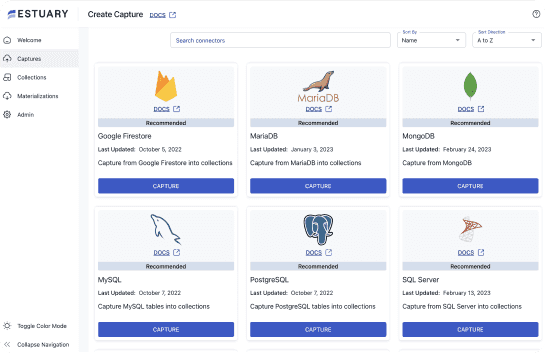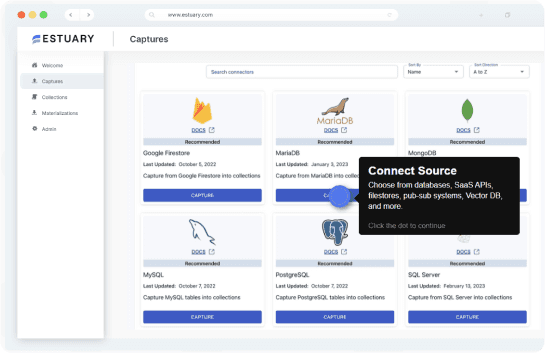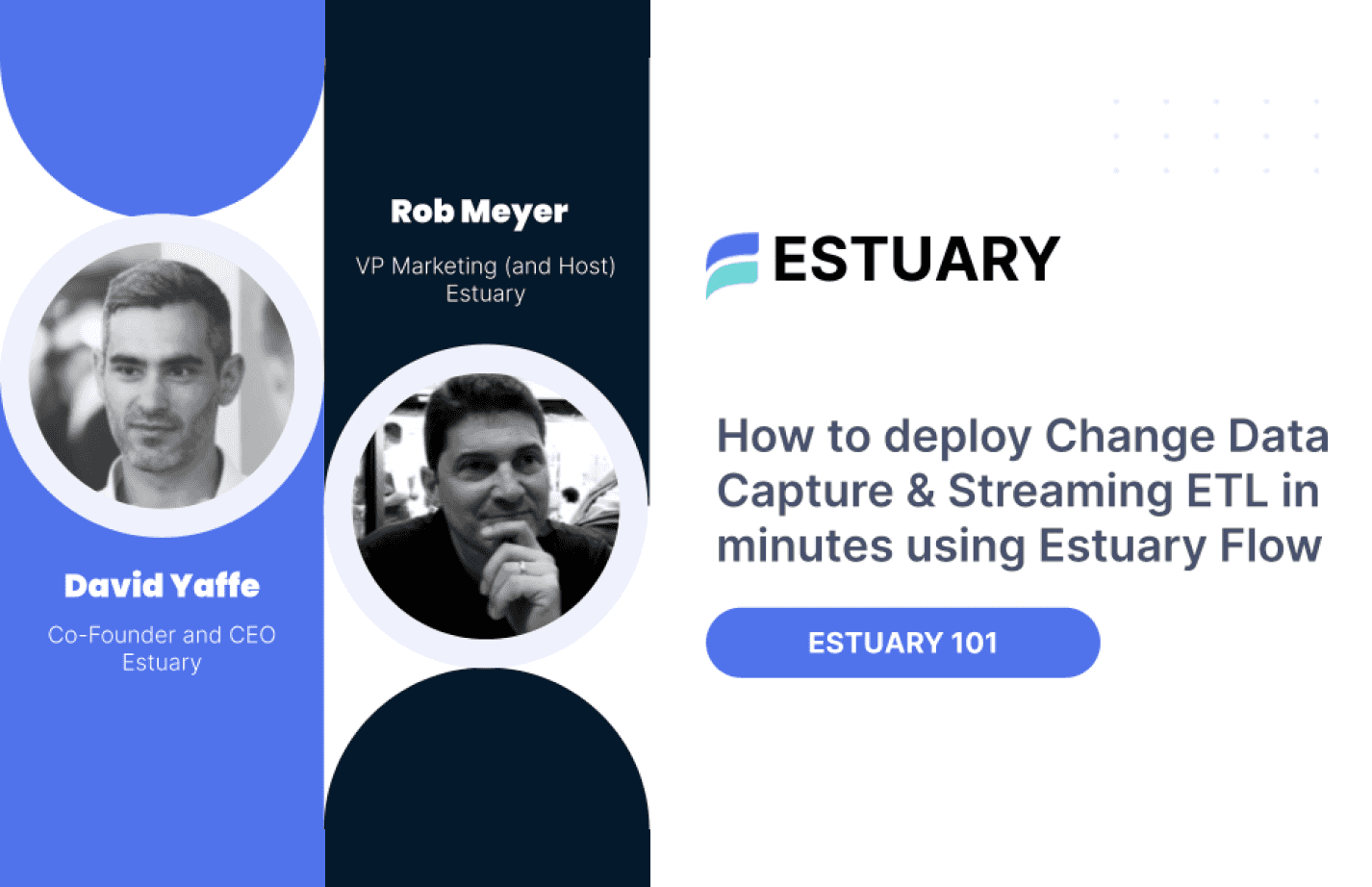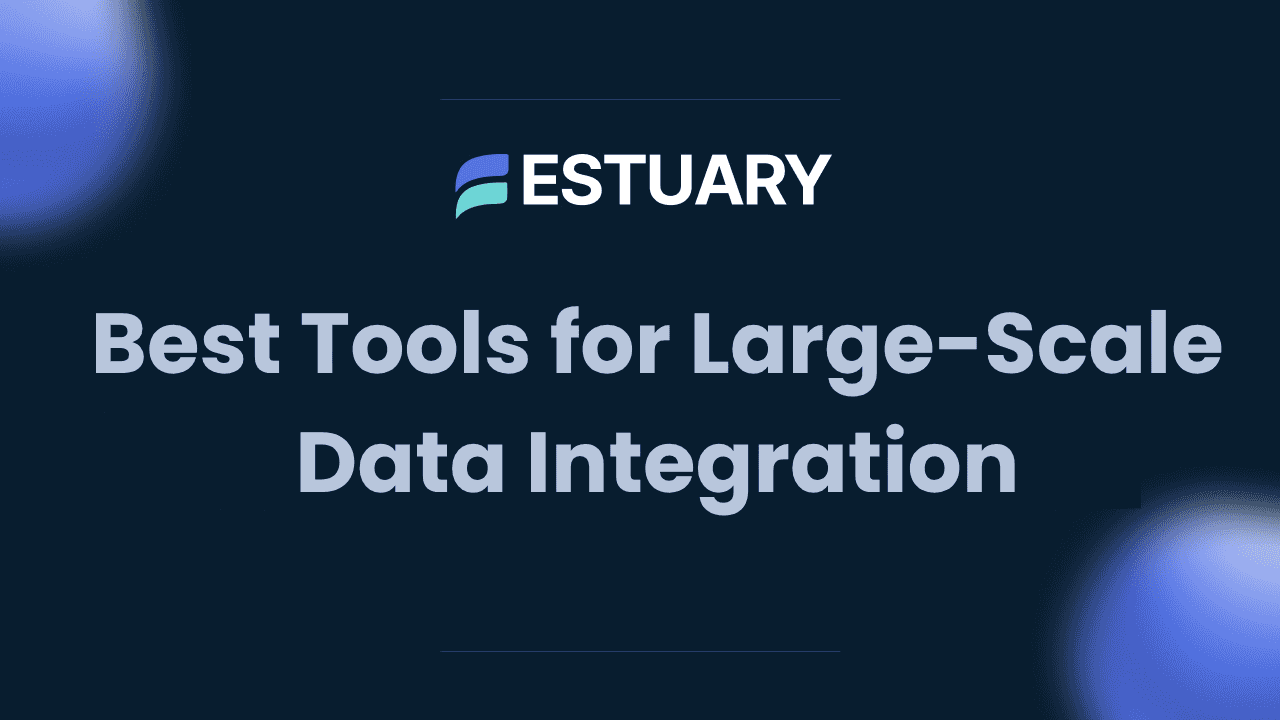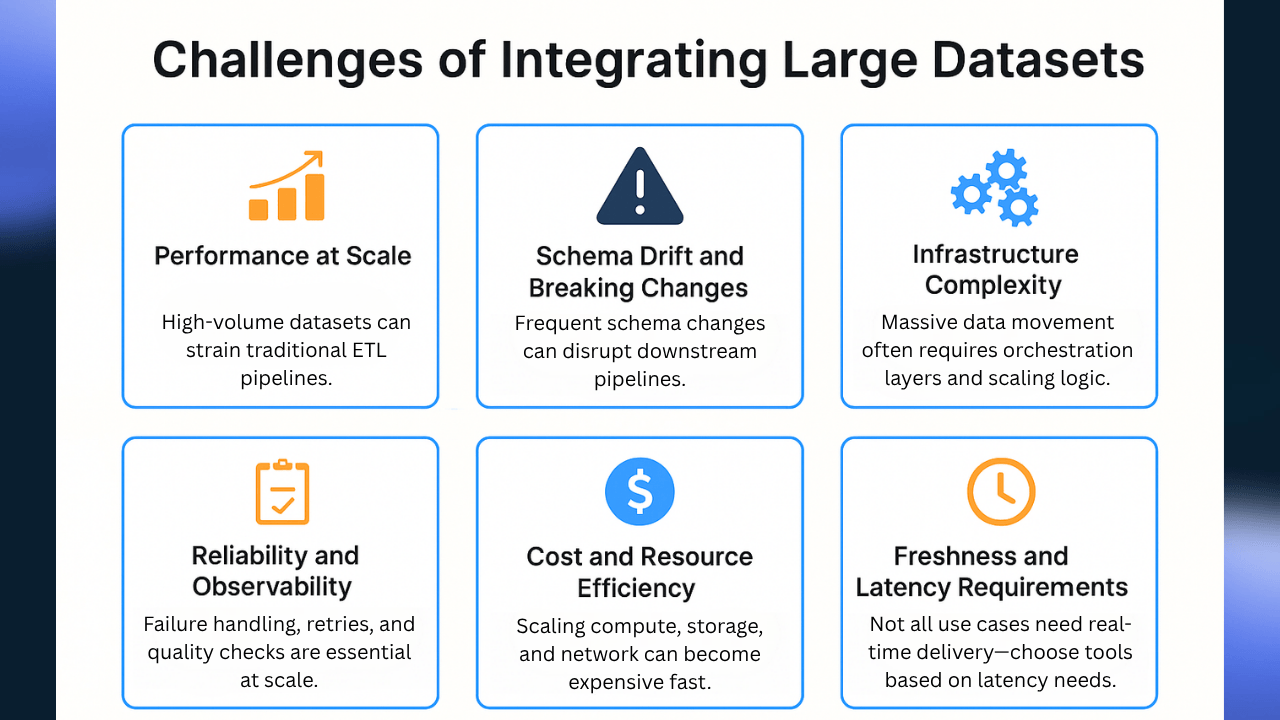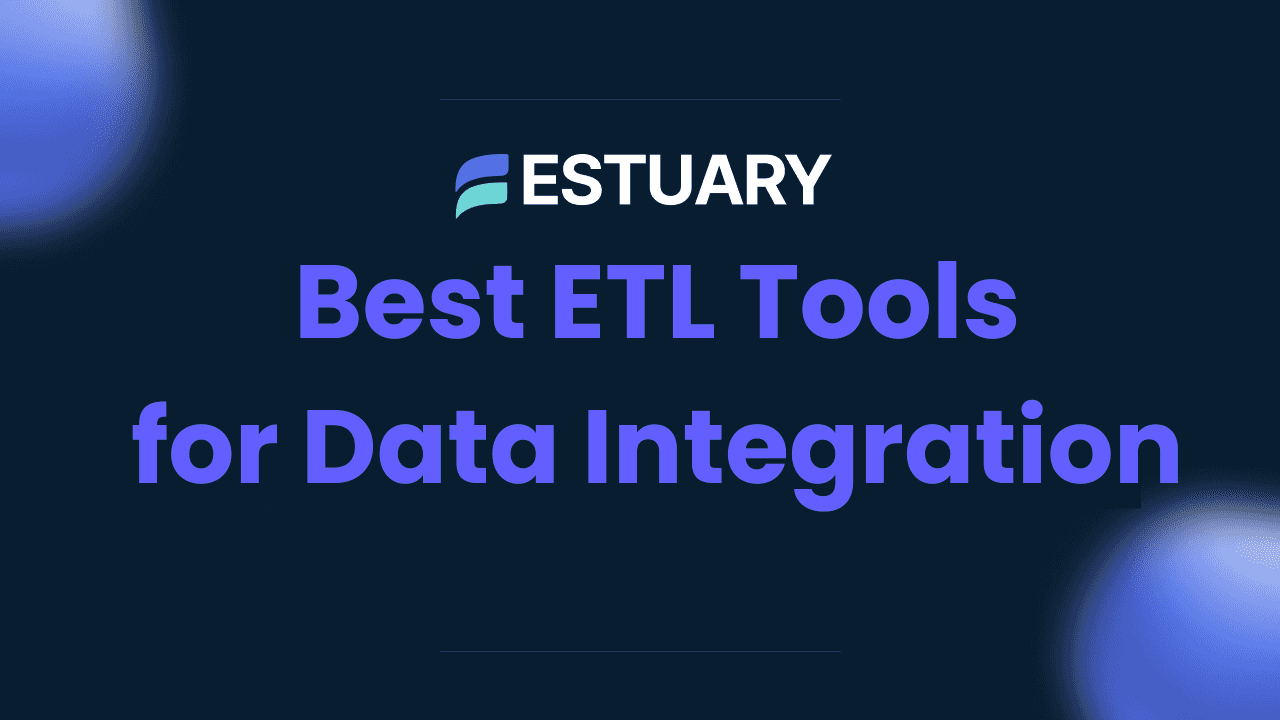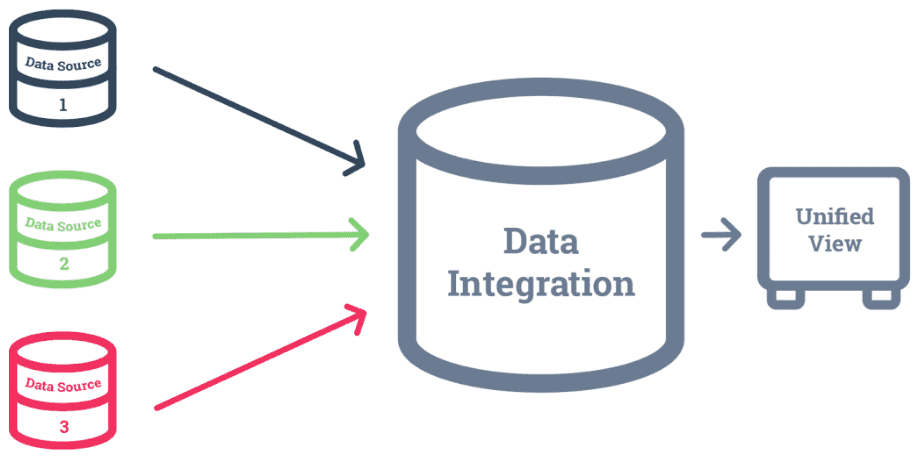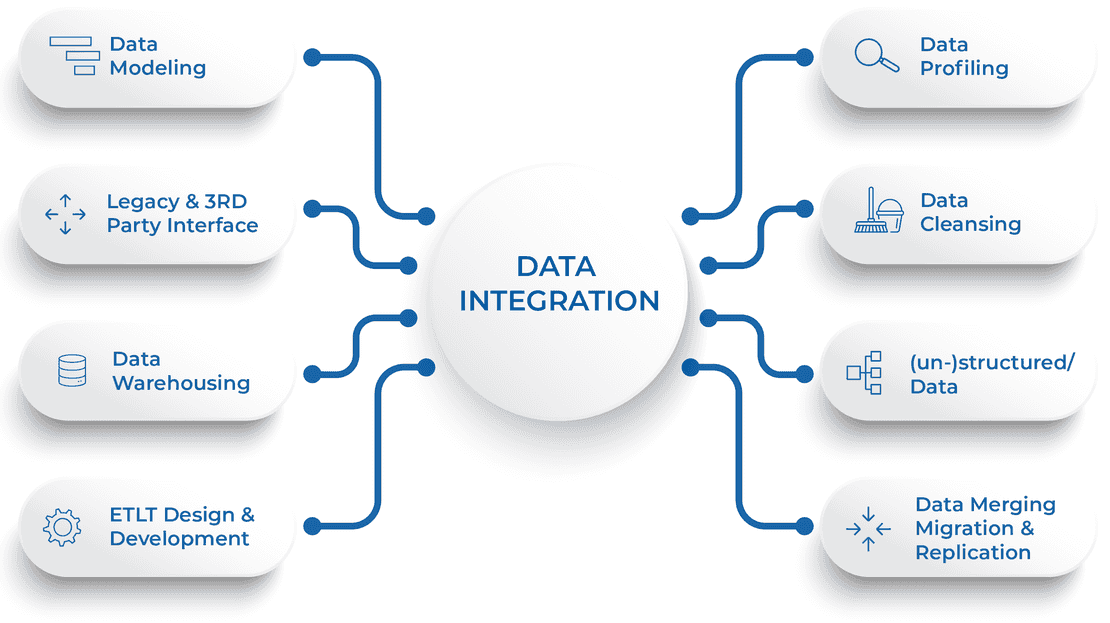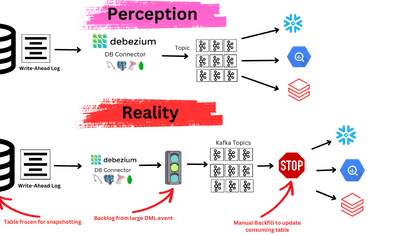
Data volumes are growing exponentially. From product analytics to AI pipelines, today’s organizations rely on integrating massive amounts of data from dozens of sources—fast, reliably, and at scale.
But traditional ETL tools weren’t built for this.
They struggle with real-time processing, break under schema changes, and rack up infrastructure costs as datasets grow into the billions of rows.
That’s why choosing the right data integration platform has become a strategic priority.
In this article, we’ll break down the top 5 data integration platforms built for companies with large datasets. These tools combine scalability, low-latency performance, and operational efficiency, so your team can move data seamlessly across systems, no matter how complex or high-volume the workload.
Challenges of Integrating Large Datasets
Integrating large datasets goes beyond just connecting tools. As data volumes grow into terabytes or billions of rows, the pressure on your infrastructure, teams, and pipelines increases significantly.
Here are the most common challenges organizations face:
1. Performance at scale
High-volume datasets can strain traditional ETL pipelines. Whether you're running hourly batch jobs or near real-time syncs, throughput and latency become critical factors as sources and sinks multiply.
2. Schema drift and breaking changes
Larger datasets usually mean more upstream systems, and more frequent schema changes. Without automated handling, even small changes can disrupt downstream pipelines and create inconsistencies.
3. Infrastructure complexity
Moving massive data across environments often requires orchestration layers, horizontal scaling, and robust monitoring. Managing this complexity takes time, resources, and specialized skills.
4. Reliability and observability
When pipelines operate at scale, failure handling, retries, and data quality checks are no longer optional—they’re essential. But many tools lack built-in observability or granular alerting.
5. Cost and resource efficiency
Scaling up compute, storage, and network resources to handle large datasets can get expensive fast. Optimizing for performance without overspending is a constant challenge.
6. Freshness and latency requirements
Not all use cases need real-time delivery, but some do. Whether it's hourly updates or sub-second syncs, choosing a tool that aligns with your latency needs is key.
The right data integration platform can reduce these risks by providing elastic scalability, flexible schema support, and the right balance between real-time and batch performance.
Which Data Integration Solution is Best for Companies with Large Datasets? Our Top Picks
Not every integration platform can handle the scale, complexity, and speed that enterprise data demands. Below, we break down the top solutions built for high-volume pipelines, real-time sync, and long-term scalability.
1. Estuary Flow
Estuary Flow is a modern data integration platform built from the ground up to support both streaming and batch pipelines at scale. It’s designed for engineering teams that need to move large volumes of data with low latency, minimal ops overhead, and strong data guarantees.
Unlike traditional ETL tools that rely on periodic batch jobs, Estuary Flow offers real-time Change Data Capture (CDC), schema enforcement, and exactly-once delivery. This makes it ideal for use cases that require both speed and reliability, like powering analytics dashboards, syncing operational databases, or feeding ML models.
Key Capabilities
- Real-time + batch in one platform - Build hybrid pipelines that support both CDC and backfills without managing multiple tools.
- Exactly-once delivery - Prevents duplicates or missed records, even at scale—critical for analytics and downstream accuracy.
- Automatic schema evolution - Handles source-side schema changes without breaking pipelines or requiring manual updates.
- Scales with your data - Whether you're syncing gigabytes or terabytes per hour, Flow’s cloud-native architecture scales elastically.
- Flexible deployment options - Choose from fully managed SaaS, Private Cloud, or Bring Your Own Cloud (BYOC) to meet compliance and control needs.
Why Estuary Flow Excels at Large-Scale Data Integration
Estuary Flow is purpose-built to handle large datasets with ease. It scales horizontally to process gigabytes or terabytes per hour without compromising performance. Built-in observability via the OpenMetrics API provides full pipeline visibility, while automatic schema evolution reduces disruptions caused by drift. Flow supports real-time CDC and historical backfills in a single pipeline, with exactly-once delivery for SLA-critical workloads. In-flight transformations using SQL or TypeScript help minimize downstream processing. With over 200 pre-built connectors—spanning databases, warehouses, and streaming platforms—Flow simplifies integration across your entire data stack. For enterprise governance and security, it includes role-based access controls, pipeline auditability, and private deployment options like BYOC and Private Cloud.
2. Talend
Talend is an open-core data integration platform that combines connectivity, transformation, and governance in one solution. It supports both batch and streaming workflows, making it flexible for a wide range of use cases across cloud and on-prem environments.
Key Capabilities
- Pre-Built Connectors - Talend integrates with virtually any source or destination, from databases and APIs to cloud services like AWS, Azure, and Snowflake.
- Hybrid and Multi-Cloud Deployment - Supports on-prem, private cloud, and public cloud environments—ideal for teams with mixed infrastructure.
- Integrated Data Quality Tools - Offers built-in profiling, cleansing, and deduplication to ensure high-trust data across pipelines.
Why Talend Is Great for Large Datasets
Talend handles large datasets by enabling parallel processing, scalable deployments, and proactive data quality enforcement. Its flexible architecture and wide connector support make it a strong fit for enterprises needing to move and govern large volumes of data across fragmented environments.
3. Informatica PowerCenter
Informatica PowerCenter has long been a cornerstone in enterprise data integration, offering robust ETL capabilities for complex, high-volume data environments. While Informatica is transitioning towards its cloud-native Intelligent Data Management Cloud (IDMC) platform, PowerCenter remains a reliable solution for organizations requiring on-premises or hybrid deployments.
Key Capabilities
- Enterprise-Grade ETL Engine - PowerCenter provides a scalable, high-performance foundation for on-premise data integration initiatives like data warehousing and analytics.
- Comprehensive Metadata Management - The platform includes robust metadata management, enabling efficient tracking, versioning, and reuse of data integration assets.
- Advanced Data Transformation- Supports complex transformations, including parsing of XML, JSON, and IoT machine data, facilitating integration of diverse data formats.
Why Informatica PowerCenter Is Great for Large Datasets
Informatica PowerCenter is built for high-volume, enterprise-grade data integration. Its scalable ETL engine and strong metadata management make it ideal for processing large, complex datasets across on-prem and hybrid environments. While many teams are shifting to cloud-native tools, PowerCenter remains a reliable choice for organizations requiring stable, on-prem infrastructure.
4. Azure Data Factory
Azure Data Factory (ADF) is Microsoft's cloud-based data integration service designed to orchestrate and automate data workflows across diverse environments. It supports both ETL (Extract, Transform, Load) and ELT (Extract, Load, Transform) processes, enabling seamless data movement and transformation at scale.
Key Capabilities
- Extensive Connectivity - ADF offers over 90 built-in connectors, facilitating integration with various on-premises and cloud-based data sources, including databases, file systems, and SaaS applications.
- Hybrid and Multi-Cloud Support - With its integration runtime, ADF enables data movement and transformation across on-premises, cloud, and hybrid environments, ensuring flexibility and scalability.
- Visual Data Flow and Orchestration - ADF provides a code-free, drag-and-drop interface for designing data pipelines and transformations, enhancing developer productivity and simplifying complex workflows.
Why Azure Data Factory Is Great for Large Datasets
Azure Data Factory is built to handle large-scale data integration tasks efficiently. Its scalable architecture allows for the processing of substantial data volumes, while its extensive connector library ensures seamless integration across various platforms. The visual interface simplifies the creation and management of complex data pipelines, making it a robust solution for enterprises dealing with large datasets.
5. SnapLogic
SnapLogic is a modern integration platform as a service (iPaaS) that leverages AI-driven automation to simplify complex data and application integration processes. Recognized as a Visionary in the 2025 Gartner® Magic Quadrant™ for Integration Platform as a Service (iPaaS), SnapLogic continues to innovate in the realm of generative integration.
Key Capabilities
- AI-Powered Integration with SnapGPT - SnapLogic's SnapGPT offers generative AI capabilities, enabling users to design and deploy integration pipelines using natural language prompts, significantly accelerating development cycles.
- Extensive Connector Library - With over 500 pre-built connectors, known as "Snaps," SnapLogic facilitates seamless integration across a wide array of applications, databases, and cloud services.
- Hybrid and Multi-Cloud Support - SnapLogic supports integrations across on-premises systems, cloud platforms, and hybrid environments, providing flexibility for diverse infrastructure needs.
Why SnapLogic Is Great for Large Datasets
SnapLogic is designed to handle large-scale data integration tasks efficiently. Its scalable architecture, combined with AI-driven automation, allows for rapid processing and transformation of substantial data volumes. The platform's extensive connector library and support for various deployment models make it a versatile choice for organizations dealing with complex, high-volume data environments.
Pricing Comparison: Top Data Integration Platforms
Modern enterprise data integration tools vary widely in pricing, architecture, and real-time capabilities. Use this comparison to evaluate which platforms offer the best balance of cost, scalability, and operational fit for large-scale, enterprise-grade data movement.
Platform | Pricing Model | Start Price | Cloud | Enterprise | Real-Time | Transformation | Governance |
| Estuary Flow | Usage-based | Free trial, then pay-as-you-go | Yes | Yes | ✅ True real-time (CDC) | Yes | Yes |
| Talend (Qlik) | Subscription (tiered plans) | Free trial, custom pricing | Yes | Yes | ⚠️ Partial (streaming add-ons) | Yes | Yes |
| Informatica PowerCenter | License-based | Custom enterprise pricing | No | Yes | ❌ Batch only | Yes | Yes |
| Azure Data Factory | Pay-as-you-go | Free trial, Custom | Yes | Yes | ⚠️ Near real-time via external services | Yes | Yes |
| SnapLogic | Subscription-based | custom pricing | Yes | Yes | ⚠️ Near real-time (triggered pipelines) | Yes | Yes |
Real-World Use Cases for Large-Dataset Integration
- Retail & E-Commerce - Retailers collect large volumes of customer behavior data—such as product views, cart activity, and transactions—to power real-time personalization and demand forecasting. Estuary Flow is often used to stream this data directly from operational databases into warehouses like BigQuery or Snowflake, enabling sub-second analytics.
- Logistics & Supply Chain - Supply chain platforms integrate data across inventory systems, shipping APIs, and fulfillment centers to ensure timely deliveries and accurate tracking. These use cases demand pipelines that can process constant updates and large file backlogs with high reliability.
- Finance & Banking - Banks and fintech platforms process high-frequency transactions, account changes, and compliance data. Integrating this data in real time supports fraud detection, customer risk scoring, and regulatory reporting. Exactly-once delivery and schema enforcement are critical in these environments.
- Marketing & AdTech - Ad platforms unify large datasets from campaign tools, attribution services, and performance trackers to inform budget allocation and creative strategy. Integration pipelines must support high data velocity, low latency, and compatibility with both structured and unstructured formats.
Conclusion
Enterprise data integration solutions are not one-size-fits-all, especially when you're working with large datasets. Some platforms excel in real-time streaming, others in governance and batch performance. The right choice depends on your infrastructure, team capabilities, and how quickly you need data to move across systems.
If your priorities include low-latency pipelines, CDC support, and simplified schema handling at scale, a solution like Estuary Flow provides a strong balance of performance and cost-efficiency. For more traditional environments or hybrid use cases, tools like Talend, Informatica, or Azure Data Factory may be more appropriate.
Ultimately, the best data integration solution is the one that fits your current data landscape and can scale with your growth. Use the comparison above to match platform strengths to your specific operational and architectural needs.
FAQs
What is the best data integration solution for large datasets?
Are there free or low-cost options for integrating large datasets?

About the author
With over 15 years in data engineering, a seasoned expert in driving growth for early-stage data companies, focusing on strategies that attract customers and users. Extensive writing provides insights to help companies scale efficiently and effectively in an evolving data landscape.

